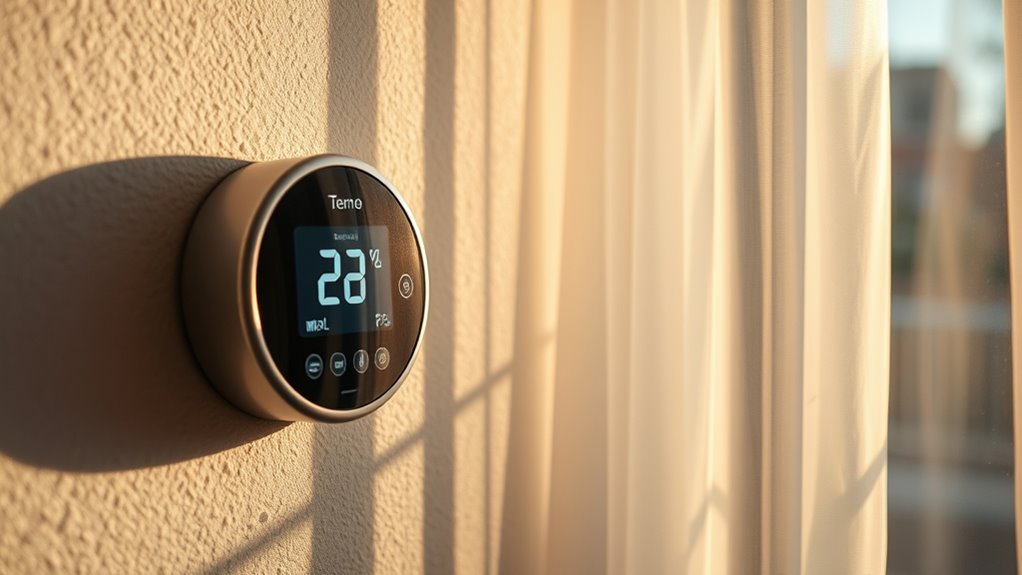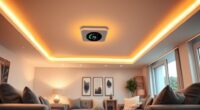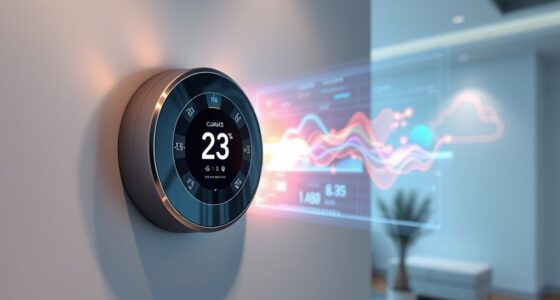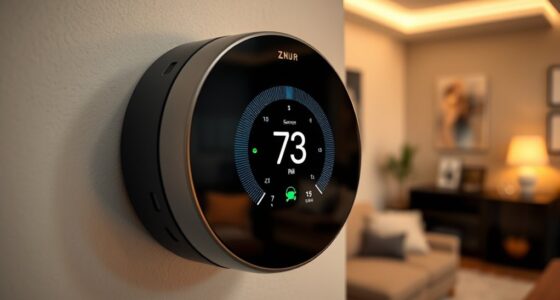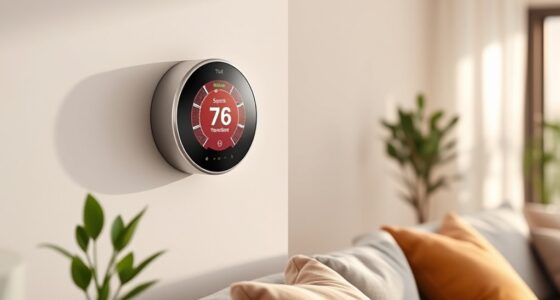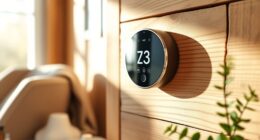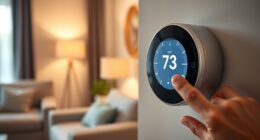Humidity considerably affects how comfortable your home feels at any thermostat setting. When humidity is too high or too low, it can make the air feel damp, stuffy, or dry, causing you to adjust your settings unnecessarily. Proper humidity levels improve perceived temperature, boost comfort, and cut energy costs. Understanding how humidity influences your thermostat response helps you create a healthier, more efficient home environment. Keep going to learn why managing humidity is key for ultimate comfort and savings.
Key Takeaways
- Humidity affects perceived temperature, influencing comfort even at constant thermostat settings.
- Proper humidity levels improve HVAC efficiency by reducing unnecessary cooling or heating cycles.
- Maintaining balanced humidity prevents air from feeling damp or dry, enhancing indoor comfort.
- Accurate thermostat calibration ensures better response to humidity changes, optimizing energy use.
- Controlling humidity reduces mold, allergens, and respiratory issues, creating a healthier indoor environment.
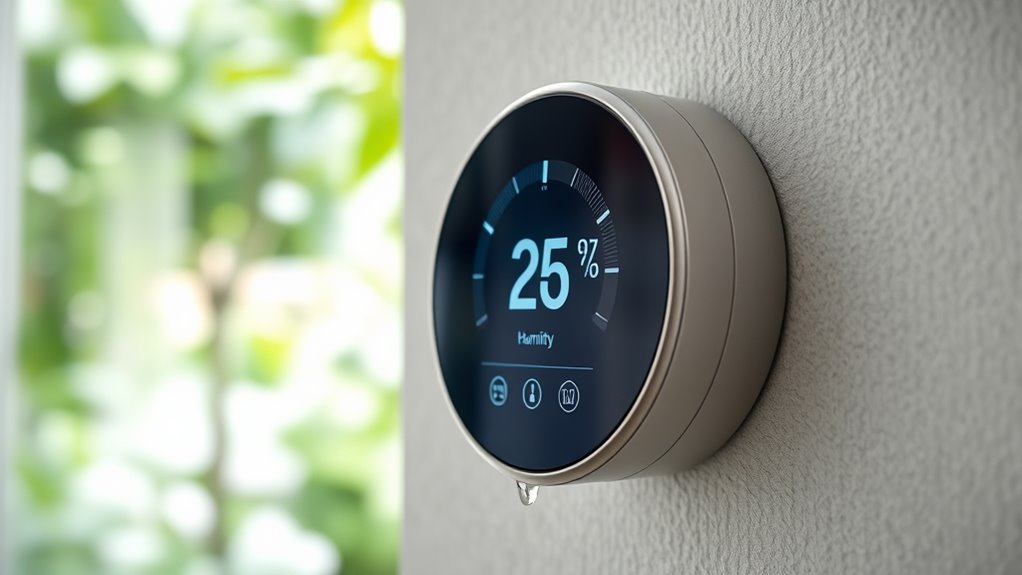
Maintaining the right humidity levels can substantially impact your comfort and energy efficiency, especially when adjusting your thermostat. When your home’s humidity is out of balance, it can make the air feel either stuffy or damp, leading you to constantly tweak your thermostat without achieving the desired comfort. Proper humidity control is essential because it directly influences how warm or cool your space feels, regardless of the actual temperature. If your home is too humid, you may notice that cooling your house feels less effective, causing your AC to run longer and use more energy. Conversely, if your home is too dry, you might feel chilly even when the thermostat is set higher, prompting unnecessary heating.
To manage this, it’s vital to understand how humidity interacts with your thermostat settings. One of the key steps in guaranteeing optimal comfort is proper thermostat calibration. When your thermostat is accurately calibrated, it can better respond to changes in temperature and humidity, preventing unnecessary cycles that waste energy. An uncalibrated thermostat might misread the room’s temperature or fail to account for humidity fluctuations, leading you to set the thermostat at an uncomfortable or inefficient level. Regularly checking and calibrating your thermostat helps keep it aligned with your actual living conditions, making humidity control more effective and your HVAC system more efficient. Additionally, understanding how humidity regulation impacts overall comfort can help you optimize your home’s environment more effectively.
Adjusting your thermostat based on humidity levels isn’t just about comfort—it’s also about health. Excess humidity can foster mold growth, dust mites, and other allergens, which can aggravate respiratory issues. On the other hand, low humidity can cause dry skin, irritated sinuses, and static electricity. By maintaining a balanced humidity level—ideally between 30% and 50%—you create a healthier environment and reduce the strain on your heating and cooling systems. This balance makes your home feel more comfortable at lower energy costs, especially when your thermostat accounts for both temperature and humidity. Incorporating low light office plants like the Snake Plant or Peace Lily can naturally help regulate indoor humidity levels, contributing to a healthier environment. Additionally, understanding how contrast ratio impacts your viewing experience can also play a role in creating comfortable indoor spaces, especially in dedicated home theaters.
Frequently Asked Questions
How Does Humidity Affect Energy Efficiency?
Humidity affects your energy efficiency by influencing how your home feels and how your heating or cooling system works. Proper humidity control helps maintain a comfortable environment without overworking your system, leading to energy savings. When humidity levels are balanced, your home stays cooler in summer and warmer in winter, reducing energy use. You can save money and improve comfort by managing humidity effectively with your thermostat settings.
Can Adjusting Humidity Levels Improve Indoor Air Quality?
Adjusting humidity levels can considerably improve your indoor air quality. When you maintain proper humidity, it reduces mold growth, which can cause health issues. Plus, it helps with allergy relief by minimizing dust mites and other allergens that thrive in damp environments. By controlling humidity, you create a healthier, more comfortable living space, making it easier to breathe and reducing allergy symptoms and mold-related concerns.
What Is the Ideal Humidity Range for Comfort?
You want to maintain the ideal humidity range for comfort, which is typically between 30% and 50%. Proper humidity control keeps moisture levels balanced, preventing dryness or excess dampness that can cause discomfort or health issues. When you set your thermostat within this range, you’ll enjoy better air quality, reduced allergens, and a more comfortable environment overall. Adjust your settings as needed to keep moisture levels just right.
How Often Should I Calibrate My Humidity Sensors?
Your humidity sensors are practically your home’s fortune-tellers, so don’t ignore their accuracy! To keep sensor accuracy sharp, you should calibrate them at least once a year, or more often if you notice inconsistent readings. Regular calibration ensures your thermostat responds perfectly to actual humidity levels, saving you energy and preventing discomfort. Think of it as giving your sensors a crucial tune-up—trust us, it’s worth the effort!
Does Humidity Impact the Lifespan of HVAC Systems?
Humidity definitely impacts the lifespan of your HVAC system. When humidity levels are poorly managed, excessive moisture can cause mold, corrosion, and strain on components. Proper humidity control helps maintain moisture balance, reducing wear and tear. By focusing on moisture management, you prevent potential damage and extend your system’s life. So, controlling humidity isn’t just about comfort; it’s a key factor in HVAC longevity and efficiency.
Conclusion
Remember, adjusting your thermostat isn’t just about temperature—humidity plays a key role in comfort and energy efficiency. Keep the humidity balanced, much like the well-tuned engines of a Model T, to prevent stuffiness or dryness. By paying attention to both, you create a cozy environment where you feel just right, no matter the season. So don’t overlook humidity, or you might find your efforts as futile as trying to tame a wild stallion without the right tools.
